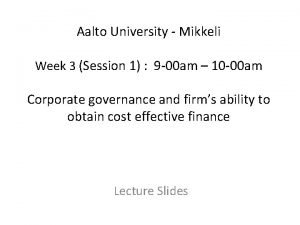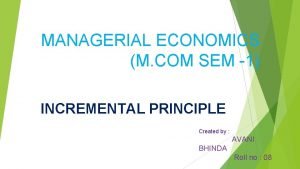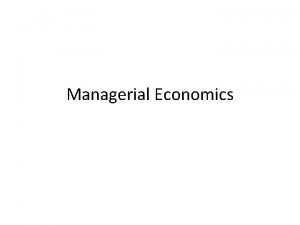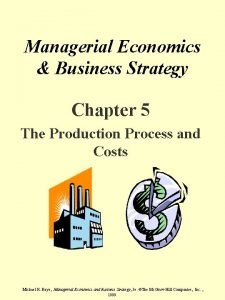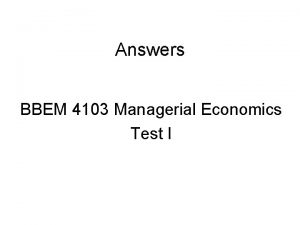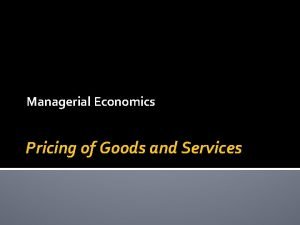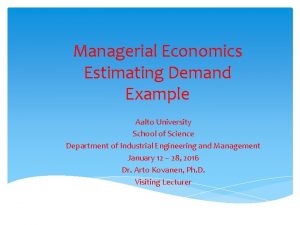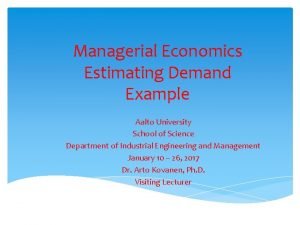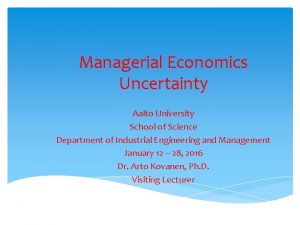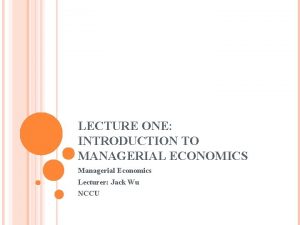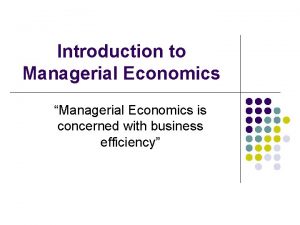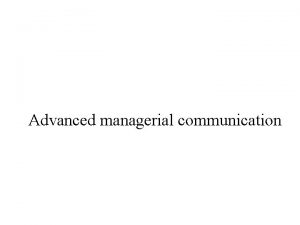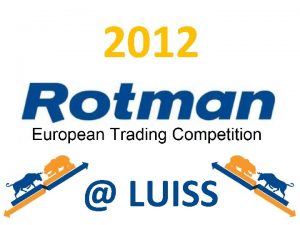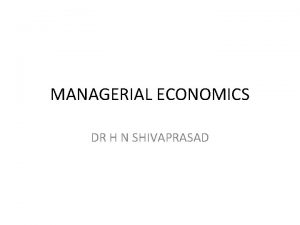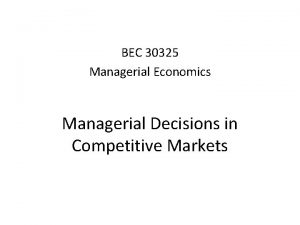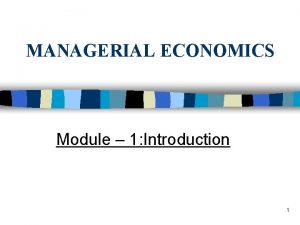Managerial Economics Some Final Thoughts Aalto University School

















- Slides: 17

Managerial Economics Some Final Thoughts Aalto University School of Science Department of Industrial Engineering and Management January 12 – 28, 2016 Dr. Arto Kovanen, Ph. D. Visiting Lecturer

Importance of Pricing … Pricing is often considered as one of the most important element in economics This is why we study demand cost theories For managers, price is just one of many decisions Pricing decisions are made in a broader context Competitive Advantage provides a useful means of analyzing corporation’s success in a market This involved analyzing corporation’s non-price decisions and explaining price decisions in this context

Competitive Advantage … As we have discussed during this course, profitability of a firm depends in general on two factors: Market conditions Competitive advantage Market conditions relate to external factors, as we have seen, not just for the firm, but for the industry Industries’ profitability varies considerably Banks and technology firms have done well Traditional industries, such as steel and transportation, performed less well Recall Porter’s paper on 5 forces shaping industries

Competitive Advantage (cont. ) As we have discussed, there are important external factors in play: Internal competition between firms in a market Restrictions for entry of new players in the market Possible substitutes and complements Supplier power Pricing power of buyers Competitive advantage relates to internal factors and determine a firm’s ability to create more value than its competitors These factors are within the control of the firm

Competitive Advantage (cont. ) A useful concept for this purpose is value creation where V = B – C V = value created B = perceived benefit to customers C = cost of inputs If we examine the standard supply – demand curves, we can identify consumer surplus (CS) and producer surplus (PS) where CS = B – P PS = P – C Then V = CS + PS = (B – P) + (P – C) = B - C

Competitive Advantage (cont. ) An example illustrates this: A consumer is prepared to pay $250 for a VCR whose price is $200; hence CS = $50 The marginal cost of producing a VCR is $130 and hence PS = $70 Consequently V = $50 + $70 = $120 If a firm has a competitive advantage, it is possible to make more profits than its competitors This is not only limited to cost advantage (i. e. , being able to produce at a lower cost), but also includes a benefit advantage

Competitive Advantage (cont. ) Cost advantage is obvious, but benefit advantage has to do with the ability to achieve higher perceived benefits to the consumer than the competitors, while maintaining a similar level of costs Recall that we assumed earlier: Firm produces a single product for a single market Firm charges the same price throughout the market Price is the only variable in the marketing mix Pricing is considered from a static, single-period point of view

Competitive Advantage (cont. ) Positioning in the market is the most fundamental aspect of a firm’s marketing strategy Cost advantage: Object is to achieve lower cost while maintaining level of benefits (services) relative to competition Examples: Woolworth, Wal-Mart and Mc. Donalds Cost advantage can be achieved through economies of scale, the learning curve, production efficiency, control over inputs (and their costs), and so on Examples: Hyundai (lower cost production of adequate quality), British sport car (TVR; sharing of components, simplified production process, etc)

Competitive Advantage (cont. ) Benefit advantage: Many car manufacturers pursue this strategy BMW and Lexus (provide same level of technology and comfort than higher-priced competitors, but at a lower sticker price) Porsche (higher price, but significantly greater quality) Ferrari and Aston Martin (charge a very high price, but promise top line performance and quality) There is also perceived value associated with the name (there are no substitutes for Ferrari, Aston Martin and Porsche), which means that customers are willing to pay a higher price for the product Apple versus Samsung is a similar story

Competitive Advantage (cont. ) Benefit advantage can be achieved in a number of ways Reputation counts for a large part in the luxury car market (e. g. , German engineering, or in the 1970 s it was common to hear that do not purchase British cars) An issue to consider by a firm is how to distribute the competitive advantage between consumer / producer surplus Cost advantage can be given to customers in the form of lower price This might help increase market share and profits

Competitive Advantage (cont. ) This, however, depends: On the price elasticity of the consumer demand (is the demand elastic or inelastic) and How other producers in the market react (would they also lower their prices to protect market share even if that means lower profit margins) Alternatively, the increased value can be translated to higher producer surplus and higher profit margin, as the company would charge the same price as others In principle, the choice depends on the elasticity of the demand whether this benefits the firm The same applies to benefit advantages

Competitive Advantage (cont. ) Market segmentation and targeting consumer groups are important for companies A market segment refers to a group of consumers in a broader market that have homogeneous features (for instance, income, age, location, lifestyle, and so on) Firms use marketing to target specific groups: For instance, adequate quality at reasonable prices (Wal. Mart, targeting consumers at lower income brackets) Sport equipment (for young professionals) Expensive, luxury cars (for wealthy) Vacation packages Pricing is an outcome of other strategic decision!

A Brief Review of the Course Material

Review of Material In this course we have covered a broad range of issues related to decision-making in a company We structured the course in the following way: Decision-making within the firm: Use of marginal analysis Understanding production processes and marginal products Understanding costs using marginal analysis Understanding consumer demand Some discussion and examples of empirical estimation of cost and demand functions

Review of Material The role of markets: We discussed different market structures (basically ranging from a perfectly competitive market to a monopoly) Although not necessarily realistic, they helped illustrate the key elements of the pricing behavior of a firm We also discussed alternative strategies that have been developed to characterize interaction in a market where there are few players We also discussed briefly: The role of government in the market Market failure and incomplete information, and Issues with public goods

Review of Material Selected other issues useful for firms: Linear optimization Asymmetric information Uncertainty and risk, and how it affects firm’s decisionmaking And today we talked about the importance of utilizing firm’s competitive advantage in its pricing

Thank you!
 Aalto university school of engineering
Aalto university school of engineering School of business and economics maastricht
School of business and economics maastricht My thoughts are not your thoughts
My thoughts are not your thoughts Aalto university mikkeli
Aalto university mikkeli Aalto university mikkeli
Aalto university mikkeli Yeah paragraph
Yeah paragraph Thoughts to ponder upon
Thoughts to ponder upon Oikonomikos kahulugan
Oikonomikos kahulugan Incremental principle example
Incremental principle example Managerial economics
Managerial economics Demand estimation and forecasting
Demand estimation and forecasting Nature and scope of managerial economics
Nature and scope of managerial economics Managerial economics chapter 5
Managerial economics chapter 5 Meaning of managerial economics
Meaning of managerial economics Managerial accounting chapter 8
Managerial accounting chapter 8 Managerial economics fundamental concepts
Managerial economics fundamental concepts Managerial economics test questions and answers
Managerial economics test questions and answers Pricing methods in managerial economics
Pricing methods in managerial economics




